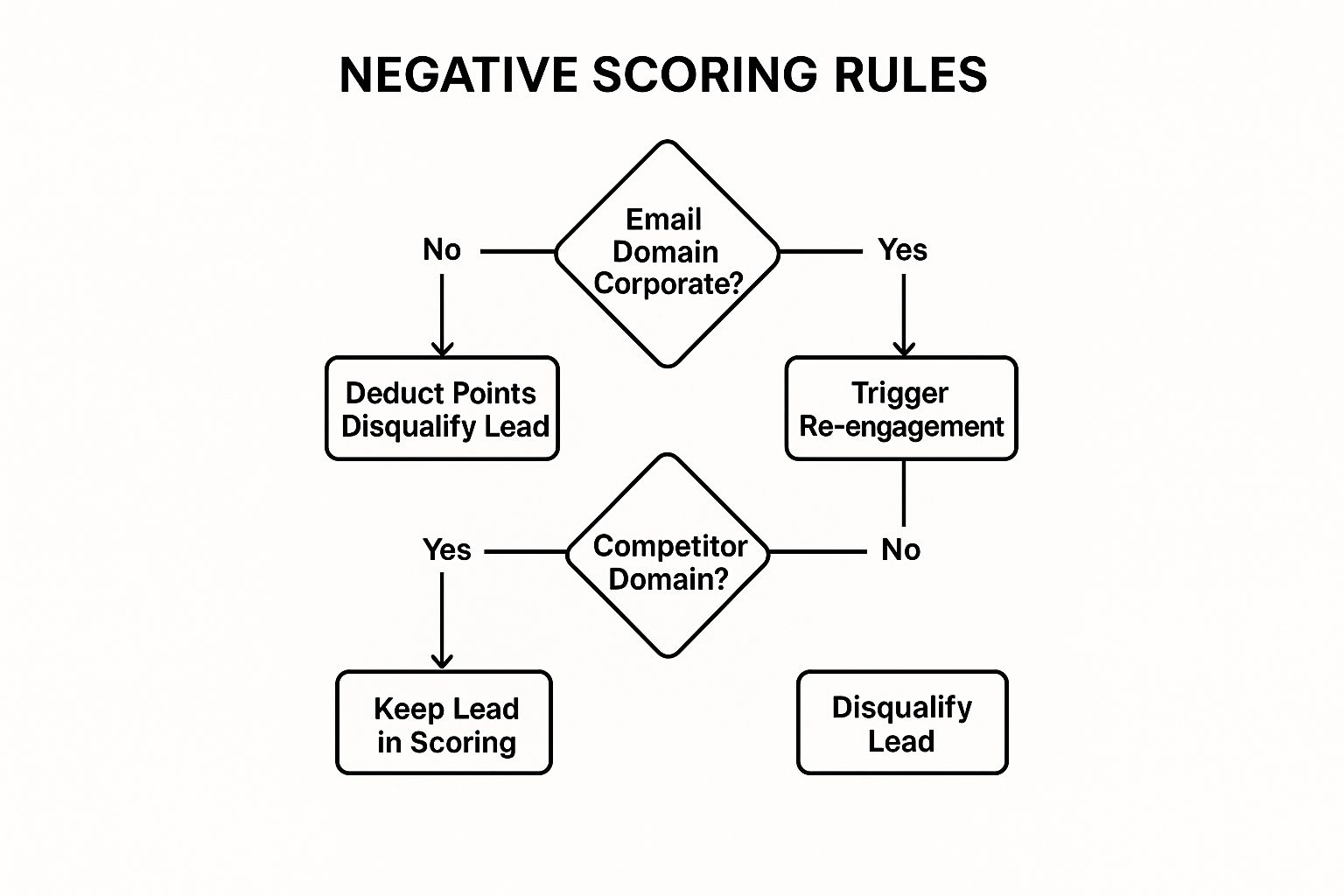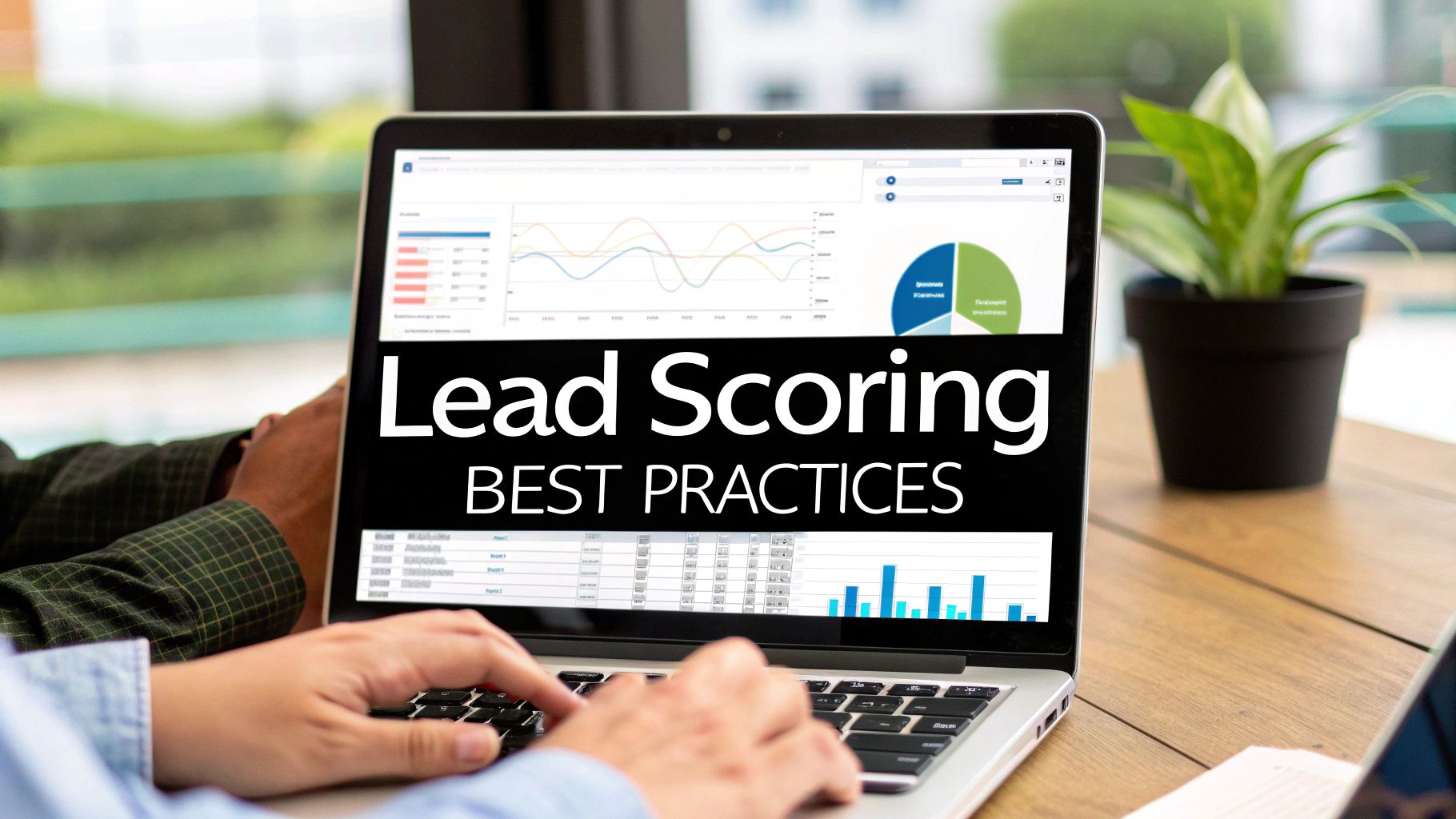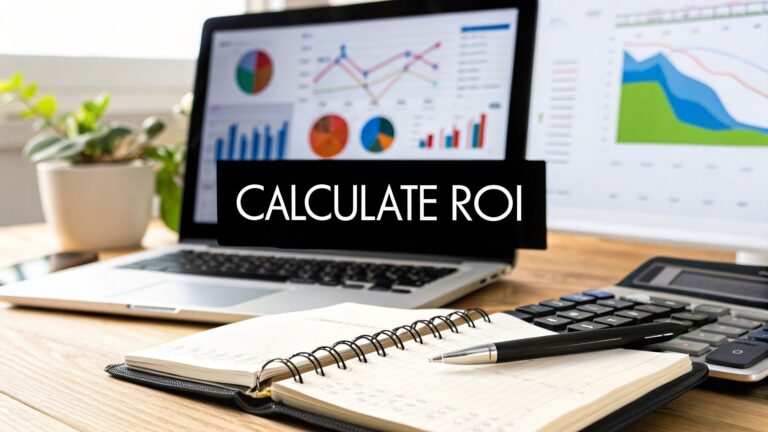8 Lead Scoring Best Practices to Boost Conversions in 2025
In the competitive B2B and SaaS landscape, not all leads are created equal. Simply generating a high volume of leads is a vanity metric; the real goal is to identify and prioritize prospects who are genuinely ready to buy. This is where a robust lead scoring system becomes your most valuable asset, transforming a flood of contacts into a predictable pipeline of sales-ready opportunities.
However, many companies struggle with outdated or arbitrary models that misalign sales and marketing, leading to wasted effort and missed revenue. If your sales team is complaining about lead quality while marketing celebrates lead quantity, your scoring system is likely broken. A poorly designed model can be worse than none at all, actively sending your best reps on wild goose chases while high-potential leads go cold.
This guide cuts through the noise to deliver a definitive collection of lead scoring best practices designed for modern growth. We’ll move beyond basic points systems to explore advanced, actionable strategies that you can implement immediately.
You will learn how to:
- Build a dynamic scoring engine that delivers high-quality, sales-ready leads.
- Align your sales and marketing teams around a unified definition of a qualified lead.
- Continuously refine your model to adapt to changing market conditions and customer behaviors.
By mastering these techniques, you'll stop wasting resources on unqualified prospects and focus your energy where it matters most: closing deals and driving sustainable growth.
1. Implement Predictive Lead Scoring Models
Traditional lead scoring relies on a manual, rules-based system where marketing and sales teams assign points to specific actions and demographic traits. While effective, this approach is static and requires constant tweaking. Predictive lead scoring, on the other hand, leverages machine learning and artificial intelligence to create a dynamic, self-optimizing model. It analyzes vast amounts of historical data-both wins and losses-to identify subtle patterns and correlations that humans might miss, ultimately creating a more accurate and reliable scoring system.

This method moves beyond simple "if-then" logic. Instead of just awarding points for a title like "VP of Marketing," a predictive model might learn that VPs from 200-500 employee tech companies who download a specific case study and visit the pricing page within 48 hours have an exceptionally high conversion rate. This level of granular insight is a core reason it ranks high among lead scoring best practices.
Why It's a Top Practice
Predictive models are not just a "nice-to-have"; they deliver quantifiable business results. For example, Salesforce's Einstein Lead Scoring helped Pandora increase lead conversion rates by 30%, and Hewlett Packard Enterprise saw a 50% jump in marketing-qualified leads (MQLs) using Marketo's predictive capabilities. The primary benefit is efficiency: sales teams waste less time on low-potential leads and can focus their energy where it matters most, driving higher conversion rates and revenue. It also adapts to market changes automatically, ensuring your scoring remains relevant without constant manual intervention.
How to Implement It
Getting started with predictive scoring requires a solid data foundation and a systematic approach.
- Gather Sufficient Data: You need a baseline of historical data for the algorithm to learn from. A common starting point is at least 1,000 historical leads with known outcomes (e.g., converted or not converted).
- Clean and Standardize: Ensure your data is clean. This means standardizing job titles, normalizing company names, and removing duplicate or incomplete records before feeding them into the model.
- Validate and Refine: Once the model is live, don't just "set it and forget it." Regularly validate its predictions against actual sales outcomes to measure its accuracy.
- Combine with Human Insight: Use the predictive score as a powerful guide, but don't ignore qualitative feedback from your sales team. Their on-the-ground experience can help explain anomalies and refine the model's focus.
Integrating this type of advanced scoring is a key component of a larger strategy. If you're interested in building a more hands-off system, you can explore ways to automate lead generation to feed high-quality data directly into your predictive model.
2. Develop Negative Scoring Criteria
While most lead scoring focuses on awarding points for positive signals, an equally powerful strategy is to deduct points for negative ones. Negative scoring is the practice of subtracting points from a lead's score when they exhibit characteristics or behaviors that indicate a poor fit or low purchase intent. This acts as a crucial filter, preventing unqualified leads from consuming valuable sales time and keeping the pipeline clean and efficient.

The decision tree above visualizes a simple yet effective workflow for applying these negative filters. This structured process helps ensure you're systematically disqualifying poor-fit leads while pushing valid prospects forward, a core tenet of effective lead scoring best practices.
Why It's a Top Practice
The primary benefit of negative scoring is its ability to dramatically increase sales efficiency. For example, Unbounce reduced its sales team's time spent on unqualified leads by 40% by implementing negative scoring for generic email domains (like Gmail or Yahoo) and certain geographic locations outside their target market. Similarly, Drift uses this method to filter out students and job seekers who interact with their content but are not potential customers. It prevents score inflation from non-buyer activity, ensuring that a high score truly reflects sales readiness.
How to Implement It
Integrating negative scoring requires identifying clear disqualifiers and creating rules to manage them without alienating potential future customers.
- Identify Obvious Disqualifiers: Start with the clearest signals of a poor fit. This often includes leads from competitor domains, students using university email addresses, or contacts from countries you don't serve.
- Implement Time-Decay Scoring: A lead who was once highly engaged but has been inactive for an extended period (e.g., 90 days) is no longer as "hot." Deduct points for prolonged inactivity to keep scores relevant. Zendesk uses this tactic to move disengaged leads into nurture campaigns rather than keeping them in the active sales pipeline.
- Balance with Positive Scoring: Be careful not to over-filter. A lead might have one negative attribute (e.g., a generic email) but several strong positive ones (e.g., visited the pricing page, requested a demo). Ensure your model weighs both sides appropriately.
- Create Re-engagement Workflows: Don't just discard leads with negative scores. Instead, move them to a separate, long-term nurturing campaign. A student today could be a decision-maker in a few years.
3. Establish Clear Lead Scoring Thresholds
A lead scoring system is only as effective as the actions it triggers. Simply assigning points to leads without a clear plan for what those scores mean creates ambiguity and inaction. Establishing specific score thresholds is the practice of defining the exact point totals that move a lead from one stage of the funnel to the next, such as from a general inquiry to a Marketing Qualified Lead (MQL) or from an MQL to a Sales Qualified Lead (SQL) ready for handoff. This creates a systematic, unambiguous process for lead management.
This practice moves lead management from a subjective "gut feel" approach to a data-driven operational workflow. When a lead hits a predefined score, an automated action occurs, whether it's enrolling them in a specific nurture campaign, assigning them to a sales development representative, or flagging them for immediate follow-up. This clarity ensures that marketing and sales teams are perfectly aligned on lead definitions and priorities, forming a cornerstone of effective lead scoring best practices.
Why It's a Top Practice
Clear thresholds are the bridge between lead scoring theory and practical sales execution. They eliminate guesswork and ensure that every lead is handled consistently and appropriately based on its demonstrated interest and fit. For instance, DocuSign reportedly set its MQL threshold at 50 points and its SQL threshold at 75 points, leading to a 20% increase in conversion rates by ensuring sales only engaged with genuinely qualified leads. Similarly, Slack uses a tiered system where each threshold (e.g., 26-50 for MQL, 76+ for hot lead) triggers different workflows, maximizing efficiency. This systematic approach ensures high-potential leads receive immediate attention while cooler leads are nurtured effectively, preventing resource waste and missed opportunities.
How to Implement It
Defining your thresholds requires collaboration between marketing and sales, grounded in historical data and a willingness to iterate.
- Analyze Historical Data: Review your past successful deals. What were the common scores of leads that converted into customers? This historical data provides a realistic baseline for setting your initial MQL and SQL thresholds.
- Start Conservatively and Adjust: It's often better to set initial thresholds slightly higher to ensure sales receives only the best leads. You can always lower them later based on conversion data and sales team feedback and capacity.
- Document and Share: Create a clear document that defines each threshold (e.g., "MQL = 50-74 points") and the specific action triggered at each level. This "Service Level Agreement" (SLA) should be a shared resource for both marketing and sales.
- Create Persona-Specific Thresholds: A lead for an enterprise product may require a higher score to qualify than a lead for a self-serve SMB product. Consider setting different threshold sets for different buyer personas or product lines to improve accuracy.
4. Align Scoring with Sales Team Feedback
A lead scoring model, no matter how data-driven, is incomplete without human intelligence. The most sophisticated algorithm can’t tell you why a seemingly perfect lead went cold after the first call. This is where aligning your scoring model with direct feedback from your sales team becomes one of the most critical lead scoring best practices. This process involves creating a systematic feedback loop where sales insights directly inform and refine your scoring criteria, ensuring the model reflects on-the-ground reality, not just marketing data.
This collaborative approach bridges the common gap between marketing-generated leads and sales expectations. When marketing understands which attributes and behaviors actually signal a sales-ready lead according to the reps working them, they can adjust the model to prioritize those characteristics. This transforms lead scoring from a theoretical marketing exercise into a practical, revenue-driving tool that both teams trust.
Why It's a Top Practice
The benefits of this alignment are tangible and directly impact the bottom line. For instance, HubSpot's internal teams use a closed-loop reporting system where sales outcomes directly inform scoring model adjustments, improving their MQL-to-customer conversion by 40%. Similarly, Salesforce holds weekly alignment meetings to review lead quality, which has resulted in a 25% improvement in SQL conversion rates. This continuous refinement cycle stops sales teams from wasting time on poorly qualified MQLs, improves morale, and significantly boosts conversion efficiency by ensuring that the highest-scoring leads are genuinely the most promising.
How to Implement It
Building a strong feedback loop requires structure and consistency, not just occasional conversations.
- Schedule Regular Scoring Reviews: Implement mandatory monthly or quarterly meetings between marketing and sales leaders specifically to discuss lead quality and scoring accuracy.
- Create a Formal Feedback Channel: Use a simple form or a dedicated Slack channel where sales reps can quickly rate the quality of a lead and provide specific notes on why it was good or bad.
- Track Conversion Reasons: Analyze not only which high-scoring leads convert but also why they don’t. Is there a common objection, a missing piece of information, or a misleading behavior pattern?
- Implement Closed-Loop Reporting: Connect your CRM and marketing automation platform so that sales outcomes (e.g., "Closed-Won," "Disqualified") are automatically synced back to the lead’s record. This provides the data needed to validate or challenge your scoring model's assumptions.
Fostering this deep alignment is a core pillar of a successful go-to-market strategy. To explore this topic further, you can learn more about sales enablement best practices and how they support a cohesive revenue engine.
5. Score Both Demographic and Behavioral Data
The most effective lead scoring systems create a holistic view of a lead by combining two critical data types: demographic and behavioral. Demographic data (explicit) tells you if the lead is a good fit for your product, covering firmographics like company size, industry, and job title. Behavioral data (implicit) reveals a lead's interest level through actions like website visits, content downloads, and email engagement. Relying on just one type provides an incomplete picture.

This dual approach prevents common pitfalls. A CEO from a target industry (great demographic fit) who only visited your homepage once has low intent. Conversely, an intern (poor demographic fit) who downloads every whitepaper is engaged but likely not a buyer. By scoring both dimensions, you can prioritize leads who are both a good fit and highly interested, which is a cornerstone of modern lead scoring best practices.
Why It's a Top Practice
Balancing fit and interest is fundamental to efficient sales cycles. Companies that successfully implement this combined scoring see significant improvements in conversion rates. For example, Mailchimp combines demographic scoring with behavioral signals to achieve 35% better lead conversion rates. Similarly, Intercom heavily weights behavioral scoring for its self-service product, tracking trial usage patterns alongside basic demographics to identify users most likely to convert to paid plans. This method ensures that the sales team engages with leads who have the authority to buy and have demonstrated active interest.
How to Implement It
Implementing a dual-scoring model requires a clear strategy for weighting and data management.
- Establish a Baseline: Use demographic and firmographic data to create a baseline score that qualifies a lead's fundamental fit. This is your initial filter.
- Layer on Behavior: Track and assign points for positive behaviors like downloading a case study, visiting the pricing page, or attending a webinar. Also, implement negative scoring for actions like unsubscribing or inactivity.
- Balance the Weights: A common B2B practice is to weight behavioral data more heavily (e.g., 60%) than demographic data (e.g., 40%), as recent actions often indicate stronger buying intent. Adjust this based on your sales cycle length.
- Factor in Recency and Frequency: A lead who visited your pricing page three times this week is more valuable than one who downloaded a whitepaper six months ago. Ensure your model rewards recent and frequent engagement.
Integrating these scores effectively is a key part of a broader automation strategy. You can learn more about how this fits into a larger system by exploring marketing automation best practices.
6. Implement Time-Based Score Decay
Not all leads remain hot forever. A prospect who was highly engaged three months ago may have lost interest, chosen a competitor, or had their project deprioritized. Time-based score decay automatically reduces a lead's score over a period of inactivity, ensuring that the leads at the top of your sales queue are the ones showing current buying intent. This prevents your pipeline from becoming cluttered with stale, disengaged contacts and keeps your team focused on timely opportunities.
This practice addresses the "shelf life" of engagement. A webinar attendance from last year, while once a strong signal, is far less relevant than a pricing page visit this week. By systematically lowering scores for inactive leads, you create a self-cleaning system that constantly reprioritizes your database based on present-day interest, a crucial element of modern lead scoring best practices.
Why It's a Top Practice
Score decay directly improves sales efficiency and pipeline accuracy. Without it, high scores from past activities can create a false sense of a large, qualified pipeline. Pardot's decay feature, for example, helped Lenovo reduce its active lead database by 40%, which simultaneously improved MQL quality and increased sales conversion rates. Similarly, ActiveCampaign users report a 25% improvement in sales team efficiency after implementing a 60-day score decay rule. The core benefit is focus: it forces your sales team to engage with genuinely active leads, leading to shorter sales cycles and more accurate forecasting.
How to Implement It
Implementing score decay requires a thoughtful approach that aligns with your business's unique rhythm.
- Align Decay with Your Sales Cycle: Start with a decay period slightly longer than your average sales cycle. If your cycle is 60 days, you might begin reducing scores after 90 days of inactivity.
- Use Tiered Decay Rates: Not all actions are equal. Consider a slower decay rate for high-value actions (e.g., a demo request) and a faster decay for lower-value ones (e.g., a blog view). This preserves the importance of foundational buying signals.
- Trigger Re-engagement Campaigns: Use score decay as a trigger. Before a lead's score drops significantly, automatically enroll them in a re-engagement or nurture campaign to try and rekindle their interest.
- Preserve, Don't Discard: A decayed lead isn't a lost lead. Instead of deleting them, move them to a long-term nurture program. Their interest may resurface later, and you'll be positioned to re-engage them.
7. Create Persona-Specific Scoring Models
A one-size-fits-all lead scoring model assumes that every potential customer travels the same path to purchase, which is rarely the case. Creating persona-specific scoring models acknowledges that different buyer types have unique needs, priorities, and buying signals. This approach involves developing separate scoring rulesets for each key customer segment, ensuring the criteria you use to measure interest are directly relevant to that specific audience.

For example, an IT decision-maker's journey might involve downloading technical whitepapers and attending integration webinars, while a business user from the same company might focus on ROI calculators and case studies. By separating these into distinct models, you can assign points more accurately. This tailored qualification is one of the most effective lead scoring best practices for B2B companies with diverse customer bases.
Why It's a Top Practice
The primary benefit of persona-specific scoring is a dramatic increase in qualification accuracy. When you align scoring criteria with what actually matters to each segment, you reduce the number of false positives sent to sales. Microsoft, for instance, creates different models for IT professionals versus business users, weighting technical content engagement higher for the former and ROI-focused content for the latter. Similarly, Adobe saw a 45% improvement in persona-specific conversion rates by distinguishing between creative professionals and marketing managers with different scoring criteria. This precision ensures that sales conversations are more relevant from the very first interaction.
How to Implement It
Building out separate models requires a strategic and data-driven approach.
- Start with 2-3 Personas: Begin with your most clearly differentiated and high-value buyer personas. Trying to build models for every possible segment at once can be overwhelming.
- Identify Persona-Specific Factors: Use historical conversion data to analyze which attributes and behaviors are most predictive for each persona. Does one persona convert after a demo while another prefers a free trial? These are your key differentiators.
- Create Tailored Content: Develop content and campaigns that align directly with each persona's scoring model. This creates a cohesive journey where their engagement naturally boosts their score.
- Validate Persona Assignment: Regularly check that your leads are being correctly categorized into the right persona buckets. Incorrect assignment will undermine the accuracy of your models.
- Monitor Cross-Persona Patterns: Pay attention to how different personas interact with content designed for others. This can reveal evolving needs or opportunities to refine your segmentation strategy.
8. Monitor and Continuously Optimize Scoring Performance
A common mistake is treating lead scoring as a "set-it-and-forget-it" project. In reality, the most effective lead scoring systems are dynamic, evolving with your business, market, and customer behavior. Continuous monitoring and optimization ensure that your model remains accurate and aligned with your revenue goals, preventing score decay and maintaining the trust of your sales team. This practice involves regularly analyzing performance data, identifying inaccuracies, and refining scoring rules to improve predictive power.
This iterative process transforms lead scoring from a static snapshot into a living, intelligent system. You might find that a high-scoring action from six months ago, like downloading a specific whitepaper, no longer correlates with high conversion rates. Without ongoing review, you would continue to prioritize these weakening leads, wasting valuable sales resources. Consistent optimization is a cornerstone of modern lead scoring best practices, ensuring your efforts deliver sustained value.
Why It's a Top Practice
The benefits of continuous optimization are directly tied to revenue and efficiency. For example, Salesforce conducts quarterly lead scoring reviews, analyzing conversion rates by score ranges and adjusting criteria. This discipline results in consistent 15-20% annual improvements in MQL quality. Similarly, Eloqua clients who implement monthly scoring optimization see an average 30% improvement in sales-accepted lead rates within six months. The core advantage is adaptability; your model stays sharp, preventing sales from chasing leads that no longer fit the ideal customer profile and ensuring marketing efforts are correctly valued.
How to Implement It
A systematic approach to monitoring and optimization is essential for long-term success.
- Establish a Review Cadence: Schedule regular, recurring meetings (monthly or quarterly) with both marketing and sales stakeholders to review lead scoring performance.
- Track Key Metrics: Monitor both leading indicators (e.g., the volume of MQLs, score distribution) and lagging indicators (e.g., MQL-to-SQL conversion rates, sales cycle length, and revenue impact).
- Create Feedback Loops: Build a formal process for the sales team to provide feedback on lead quality. This qualitative data is crucial for understanding why certain leads are not converting, even with high scores.
- Document and Test Changes: Keep a detailed log of every adjustment made to the scoring model and its impact. Before rolling out significant changes, use A/B testing on a small segment of leads to validate the new logic and prevent widespread disruption.
Lead Scoring Best Practices Comparison
| Item | Implementation Complexity | Resource Requirements | Expected Outcomes | Ideal Use Cases | Key Advantages |
|---|---|---|---|---|---|
| Implement Predictive Lead Scoring Models | High – needs historical data & data science expertise | Significant – data, technical skills, CRM integration | Improved lead quality and conversion rates | Organizations with rich historical lead data | High accuracy; adapts over time; reduces bias |
| Develop Negative Scoring Criteria | Moderate – needs careful rule-setting and calibration | Moderate – scoring setup and ongoing adjustments | Fewer unqualified leads; better sales focus | Preventing sales time wasted on poor fits | Improves lead quality; reduces acquisition costs |
| Establish Clear Lead Scoring Thresholds | Low to Moderate – define and maintain score ranges | Low – mainly planning and workflow setup | Consistent lead handling; clear sales handoff | Standardizing lead qualification process | Eliminates guesswork; enables automated workflows |
| Align Scoring with Sales Team Feedback | Moderate – requires collaboration and process setup | Moderate – time investment from teams | Better model accuracy and sales adoption | Improving alignment between marketing & sales teams | Enhanced lead quality; stronger team buy-in |
| Score Both Demographic and Behavioral Data | High – complex data integration and balance | Significant – data collection and maintenance | Comprehensive lead insights; better prioritization | Businesses tracking both fit and engagement | More nuanced scoring; captures multiple signals |
| Implement Time-Based Score Decay | Moderate – needs configuration of decay parameters | Moderate – automation and monitoring | Keeps lead scores current; reduces stale leads | Maintaining pipeline freshness | Prevents focus on inactive leads; triggers re-engagement |
| Create Persona-Specific Scoring Models | High – multiple models and criteria per persona | Significant – detailed persona data and maintenance | More accurate qualification for segments | Diverse customer segments with distinct behaviors | Better alignment; improved conversion rates |
| Monitor and Continuously Optimize Scoring Performance | High – requires ongoing analysis and optimization | Significant – analytics tools and expertise | Maintains model effectiveness; continuous improvement | Long-term lead scoring management | Avoids model degradation; data-driven adjustments |
From Theory to Action: Automating Your Lead Scoring Success
Navigating the complexities of modern B2B sales requires more than just generating leads; it demands a sophisticated, data-driven system for identifying the right leads at the right time. Throughout this guide, we've unpacked the essential lead scoring best practices that transform a chaotic funnel into a predictable revenue engine. Moving beyond basic point allocation, we have established a clear framework for building a dynamic and intelligent lead qualification system.
The journey from a rudimentary scoring setup to a finely tuned model is built on several core pillars. We started by exploring the power of predictive models, which leverage AI to uncover hidden patterns and forecast lead quality with remarkable accuracy. We then emphasized the critical, yet often overlooked, practice of implementing negative scoring to actively filter out poor-fit prospects, saving your sales team invaluable time and energy.
Establishing clear, data-backed thresholds between MQLs, SQLs, and disqualified leads ensures a smooth, unambiguous handoff process. This clarity is only possible when you foster a tight feedback loop with your sales team, treating their on-the-ground insights as the ultimate source of truth for refining your scoring criteria.
Synthesizing Your Strategy for Maximum Impact
A truly effective lead scoring system is never static. Its strength lies in its ability to adapt and evolve. To achieve this, remember the key takeaways that serve as the foundation of a successful program:
-
Holistic Data Integration: The most accurate scores come from a balanced view of a lead. This means combining explicit demographic and firmographic data (like job title and company size) with implicit behavioral signals (like page views and content downloads). One without the other tells only half the story.
-
The Principle of Timeliness: A lead's engagement from six months ago is not as relevant as their activity today. Implementing score decay ensures that your system prioritizes current, active interest, reflecting the real-world urgency of a prospect's buying journey.
-
Precision Through Personalization: One-size-fits-all scoring models are a relic of the past. By developing distinct scoring models for each of your key buyer personas, you align your qualification criteria with the unique pain points, motivations, and buying signals specific to each segment.
-
Commitment to Iteration: Your lead scoring model is a living system. Continuous monitoring of conversion rates, sales cycle lengths, and win rates is not just a best practice; it's a necessity. This ongoing optimization ensures your model remains aligned with shifting market dynamics and evolving customer behavior. These principles of continuous improvement are not just for sales funnels; understanding the role of marketing automation in higher education shows how these data-driven outreach strategies can be adapted across various sectors to nurture prospects effectively.
The True Value of Mastering Lead Scoring
Implementing these advanced lead scoring best practices is about more than just efficiency; it’s a strategic imperative. It forges a powerful alliance between marketing and sales, ensuring both teams are working from a single source of truth and are focused on the same goal: converting high-potential leads into loyal customers. It replaces guesswork with data-backed confidence, allowing your sales representatives to engage in meaningful conversations with prospects who are genuinely ready to buy.
By automating this crucial qualification process, you free up your team to focus on what they do best: building relationships, solving problems, and closing deals. This is not just an operational upgrade; it's a fundamental shift that fuels scalable growth, maximizes ROI, and builds a sustainable competitive advantage in a crowded marketplace.
Ready to transform your lead scoring from a manual chore into an automated revenue driver? At MakeAutomation, we specialize in designing and implementing sophisticated, data-driven lead scoring systems that integrate seamlessly with your existing tech stack. Let us build the framework that empowers your sales team to close more deals, faster. Schedule your free consultation today!







